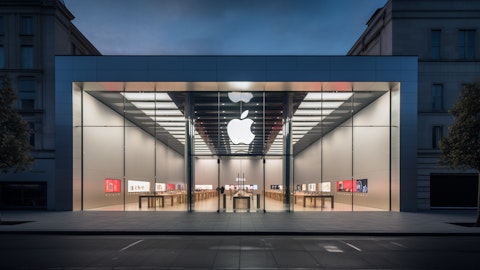InterDigital, Inc. (NASDAQ:IDCC) Q3 2025 Earnings Call Transcript October 30, 2025
InterDigital, Inc. beats earnings expectations. Reported EPS is $1.93, expectations were $1.79.
Operator: Good morning, and welcome to InterDigital’s Third Quarter 2025 Earnings Conference Call. [Operator Instructions] Please be advised today’s conference is being recorded. I would now like to hand the conference over to Raiford Garrabrant, Head of Investor Relations. Please go ahead.
Raiford Garrabrant: Thank you, Haley, and good morning. Welcome to InterDigital’s Third Quarter 2025 Earnings Conference Call. I am Raiford Garrabrant, Head of Investor Relations for InterDigital. With me on today’s call are Liren Chen, our President and CEO; and Rich Brezski, our CFO. Consistent with prior calls, we will offer some highlights about the quarter and the company, and then open the call up for questions. For additional details, you can [Technical difficulty]. In this call, we will make forward-looking statements regarding our current beliefs, plans and expectations, which are not guarantees of future performance and are made only as of the date hereof. Forward-looking statements are subject to risks and uncertainties that could cause actual results and events to differ materially from results and events contemplated by such forward-looking statements.
These risks and uncertainties include those described in the Risk Factors sections of our 2024 annual report on Form 10-K and in other such [Technical difficulty] presentation may contain references to non-GAAP financial measures. Reconciliations of these non-GAAP financial measures to the most directly comparable GAAP financial measures are included in the supplemental materials posted to the Investor Relations section of our website. With that taken care of, I will turn the call over to Liren.
Lawrence Chen: Thank you, Raiford. Good morning, everyone. Thanks for joining us today. This was another outstanding quarter for InterDigital. We completed Samsung smartphone arbitration and signed 4 new license agreements. We increased our annualized recurring revenue by 49% year-over-year to an all-time high of almost $590 million. We appointed a new Chief Licensing Officer. One of our senior wireless engineer was reelected to a chair position to lead the development of next-generation wireless standard, including 6G. And this morning, we announced that we completed the acquisition of an AI start-up to add significant expertise to our research teams and accelerate our AI native video research. Our business success was also recognized in recent high-profile rankings from Newsweek, Fortune and Time Magazine.
Revenue for the third quarter was up 28% year-over-year to $165 million. Adjusted EBITDA and non-GAAP EPS were up 62% and 56% respectively year-over-year. In the quarter, we also increased our dividend by 17% to $0.70 per share. And over the course of the year, we have returned more than $130 million in capital to shareholders. As with previous calls, Rich will dig deeper into the numbers while I recap our recent business highlights and how we are executing our long-term growth strategy. Last month, we announced the appointment of Julia Mattis as our Chief Licensing Officer. Over the last 15 years at InterDigital, Julia has served in a series of leadership roles within the licensing team, including Chief Licensing Counsel, Head of Smartphone Licensing and most recently as our Interim Chief Licensing Officer.
She has played a critical role in negotiating many of our largest license, including Apple and Samsung. I’m thrilled about this appointment, and I’m confident she has the right skill set and experience to thrive in her new role. At the beginning of Q3, we announced that we have completed the Samsung smartphone arbitration valued at more than $1 billion over 8 years. Together with Apple, we have 2 largest smartphone manufacturers licensed through the end of this decade. As a reminder, after announcement of Samsung license, we raised our annual guidance by $110 million to $820 million at the midpoint. Also in the third quarter, we signed a new license with Honor, a top 10 smartphone vendor based in China. The agreement follows our recent agreement with OPPO and Vivo.
We now have 8 of the top 10 smartphone vendors and around 85% of the total market under license. The license also increased our annualized recurring revenue by $26 million to a record setting of $588 million. Of the $588 million in ARR, our smartphone program now accounts for over $490 million, putting us very close to our midterm goal of $500 million in recurring revenue from smartphone by 2027. Following the conclusion of our Honor agreement, we are taking active steps to license the 2 remaining top 10 smartphone vendors. These include initiating enforcement proceeding against Tencent in court in UPC, India and Brazil. As I have said before, while we always prefer to complete licensing deal through bilateral negotiation, we will take all necessary steps to ensure we receive fair value for our foundational innovation.
In the third quarter, we also closed renewal with Sharp and Seiko in our smartphone program and with an EV charging company in our consumer electronic and IoT program. The agreement with the EV charging company is another example of how our horizontal technology has broad applicability across different industry verticals. Overall, the total contract value for license that we have signed since 2021 is now well over $4 billion. In our video service program, we are making more progress in enforcing efforts with Disney. Last month, a court in Brazil granted us a preliminary injunction against Disney. After a court appointment, independent experts found that Disney infringed our 2 patent suit related to video including technology. The independent expert report contained a detailed analysis of our innovation and the role it plays in enabled Disney’s various streaming platforms, validating our belief that our portfolio is a critical enabler for the video service sector.
The preliminary injunction in Brazil is an important early step in our multi-jurisdictional enforcement campaign with Disney. As I mentioned before, we always prefer bilateral negotiation to get deals done and only use enforcement as a last resort. High-value litigation like this can be lengthy, but when choosing to enforce — when we choose to enforce our right, we have a very strong track record of ultimately signing long-term agreement with the prospective licensee. So as we drive our growth strategy across devices and services on the video side, we continue to strengthen our research and innovation team. Earlier today, we announced our acquisition of AI start-up Deep Render, which specializes in the application of AI to make video compression more efficient.
Let me explain why we believe the deal is such a great thing. This acquisition added our existing AI talent pool in our research and innovation team. It accelerates our AI native video research. It strengthens our position in foundational research as the next video compression standards started to take shape and build on our current leadership in HEVC and VVC CUDA, and it has depth in our IP position with Deep Render’s AI and video patent portfolio. I will also add this is a great cultural match. Much like InterDigital, Deep Render is a company of researchers and inventors who are dedicated to solve some of the most complex technical challenges in video and AI. With the consumption of video booming across smartphones, consumer electronics and video services, such as streaming, we believe that our video innovation will become an even more significant driver of our growth strategy.

Staying with our research teams, in the third quarter, one of our senior wireless engineers were reelected to lead a key engineering group within 3GPP, the organization, which set cellular wireless standards. This shows not only how we lead 5G, but also means that we are ideally positioned to lead the development of 6G ahead of the expected rollout of next-gen mobile network devices and services in 2030. Shortly after the end of the quarter, we also announced that we have been awarded a contract by National Spectrum Consortium in partnership with the U.S. government to lead research and conduct demonstrations on how to better manage the use of spectrum in the United States by both civil and military applications. This project reflects one of InterDigital’s unique strength in solving complex technical challenges to improve connectivity for consumers and in price and enhancing national security across communication ecosystem.
There are very few companies worldwide that can take on this sort of challenge, and I’m delighted that United States has turned to our engineering team for help. As we continue to execute on our growth strategy, our progress are recognized by third parties. Newsweek recently named us as one of American’s greatest companies, Fortune recognized as one of American’s fastest-growing companies and Time Magazine listed us among American’s Growth Leader of 2025. This award reflects the dedication and strong contributions from our employees and why we believe our platform has never been stronger to deliver more growth and even more shareholder value. And with that, I’ll hand you over to Rich.
Richard J. Brezski: Thanks, Liren. I’m pleased to report that our strong growth momentum continued in Q3 with revenue, adjusted EBITDA and non-GAAP EPS all exceeding the high end of our guidance range. Our Q3 performance was powered by our Samsung arbitration result and new license agreements, including a license with Honor, a top smartphone manufacturer based in China. These new agreements helped drive total revenue of $165 million, an increase of 28% year-over-year. This exceeds both our initial top-end guidance for Q3 total revenue of $140 million and our updated increased top-end guidance of $159 million that we announced at the time we signed Honor. The upside we delivered compared to our increased guidance was driven by additional license agreements we signed since then.
Our annualized recurring revenue, or ARR, increased 49% year-over-year to another all-time high of $588 million in Q3. This year-over-year growth was driven primarily by new agreements signed over the intervening year in our smartphone program, including license agreements with OPPO, Vivo, Lenovo and most recently, Honor. In this time, we increased our share of the smartphone market under license from about 50% to roughly 85%. These agreements, together with our excellent Samsung arbitration result, increased our smartphone ARR 65% year-over-year to $491 million in Q3, almost at the level of our smartphone midterm ARR goal of $500 million. In CE and IoT, ARR increased to $97 million in Q3, also an all-time high. Our new license with an EV charger company is another example of the growth opportunities that exist beyond the smartphone market, and we believe we can more than double ARR from CE and IoT by 2030.
Our subscription-based IP-as-a-Service model offers a high level of visibility and provides a reliable source of cash flow even in the face of an uncertain economic environment. This enables us to continue to fuel our innovation engine and drive future revenue growth. Based on the strength of our intellectual property and the huge markets built upon it, we believe we are on track to grow ARR at a double-digit CAGR towards our 2030 target of $1 billion plus. And it’s important to remember that while ARR is a great metric to track the growth of our business, there is economic value above ARR alone. Over the last 10 years, we have recognized $1.5 billion of catch-up revenue. This has been tremendously valuable because we have used the majority of that money to fund share repurchases over that time period.
Today, we continue to have a lot of catch-up opportunity remaining, which tends to be 100% gross margin as we pursue our goal of 100 — excuse me, $1 billion of ARR by 2030. Our adjusted EBITDA for the quarter of $105 million increased 62% year-over-year and equates to an adjusted EBITDA margin of 64%, an increase of 14 points compared to 50% a year ago. The significant increase in adjusted EBITDA margin year-over-year demonstrates the leverage inherent in our model. You might remember that on our last earnings call, I said strong free cash flow over the second half of the year would drive free cash flow for the full year of 2025 above $400 million or close to double 2024 levels. I am happy to report we did, in fact, collect large payments during the quarter, driving free cash flow to $381 million for the quarter and $425 million year-to-date.
Finally, non-GAAP EPS rose 56% year-over-year to $2.55 and exceeded our increased guidance of $2.08 to $2.27 per share. Consistent with our capital allocation priorities, we continue to maintain a fortress balance sheet, invest for growth and return excess capital to shareholders. In Q3, we increased our dividend by 17% and returned $53 million to shareholders through $35 million in buybacks and $18 million through dividends. In October, we bought back another $15 million of stock, bringing total return of capital to more than $130 million year-to-date. In just the last 3-plus years, we have repurchased more than $0.5 billion of stock, and we expect to continue to buy back shares over the remainder of this year. Looking forward to Q4, we expect recurring revenue will include $144 million to $148 million of revenue from existing contracts.
That means we expect full year revenue from existing contracts will be $820 million to $824 million. So before adding any potential contributions from new agreements we may sign over the next 2 months, we expect to meet or beat the midpoint of the increased full year guidance we issued last quarter. Of course, revenue from any new agreements we may sign over the balance of the quarter would be additive to these amounts. Based again only on existing contracts, in Q4 we expect an adjusted EBITDA margin of about 50% and non-GAAP diluted earnings per share of $1.38 to $1.63. For the full year, again based only on existing contracts, we expect an adjusted EBITDA margin of 70% and non-GAAP diluted earnings per share of $14.57 to $14.83 for the full year.
With that, I’ll turn it back to Raiford.
Raiford Garrabrant: Thanks, Rich. Before we move to Q&A, I’d like to mention that we’ll be attending a number of investor events in Q4, including the RBC Tech Conference and the ROTH Tech Conference, both in New York City; the Southwest IDEAS Conference in Dallas; and the NASDAQ Investor Conference in London. Please reach out to your representatives at those firms if you’d like to schedule a meeting. At this point, Haley, we are ready to take questions.
Q&A Session
Follow Interdigital Inc. (NASDAQ:IDCC)
Follow Interdigital Inc. (NASDAQ:IDCC)
Receive real-time insider trading and news alerts
Operator: [Operator Instructions] Our first question comes from the line of Kevin Garrigan from Jefferies.
Unknown Analyst: Congratulations on the strong results. I just want to drill in on the consumer IoT side. So just wondering if you can walk us through your biggest prospects as we look for the rest of the year and into 2026. And your first agreement with an EV charging manufacturer, do you guys see that — see the EV charging space being a significant contributor to ARR growth?
Lawrence Chen: Kevin, this is Liren. Regarding the consumer electronic IoT space, if you look at — this is really a class of multiple opportunities. Our largest single opportunity under the consumer electronics is smart TVs where we continue to make progress. We have licensed the largest TV maker, Samsung. We are currently working on with multiple use, the next few players, including LG, Hisense and TCL. So that’s our largest opportunity. Regarding IoT opportunities here, we also have quite a different collections, including automobile, EV charging as we announced today and a few other consumer-driven IoT platforms. One more thing I also want to emphasize is in our consumer electronics also include PCs and desktops. So if you go our supplemental deck on our IR website, we have to try to break it down what the size of market where we are in each segment.
Regarding your question for EV charging, we do think that it’s an interesting market for us. It’s growing because some of the charging market is consumer-driven, some of them is commercial driven, and they have different technology in there. Some of them is Wi-Fi enabled and some others that we have cellular connectivity, and we try to get a value that’s fair towards the technology that’s incorporated in those devices — those stations.
Unknown Analyst: Got it. Okay. That makes sense. And then as a follow-up, can you just explain a little bit more on how you plan to integrate Deep Render with your own video codec technology and not to give away any plans, but are there other companies out there that you’re looking into to kind of complement your streaming business?
Lawrence Chen: Kevin, yes, good question. This morning, we announced the closing of Deep Render. Deep Render is a start-up company. They are headquartered in London. And what they have been focusing on is this thing called native AI for video CUDA end-to-end. So it’s really a more different way of solving the problem end-to-end by incorporating the AI function from bottom up. So we introduced an AI team. We have been working on video space for, frankly, many, many years. And the native AI function is one of the areas we have been working on. But by acquiring this team, we added a lot of really strong expertise, speed up our AI capability for the native AI video research. And interesting enough, it’s also a critical juncture of time for next generation of video standard that’s coming under discussion.
So we feel we have a strong chance of integrating some of the AI feature into the next video standard. And then lastly, as part of the acquisition, we bought the different IP patent portfolio team and patent portfolio. So there are some AI patents and video patents, and we are in the process of integrating. So it’s a strategic acquisition, and we feel very good about it. Regarding other opportunities, we frankly have a very robust pipeline. We are looking at all kinds of different opportunities and have a dedicated team passing through them and — but I don’t have anything else to report at this time.
Operator: Our next question comes from the line of Scott Searle from ROTH Capital.
Scott Searle: I apologize, Liren, if this was covered earlier, I got on the call a little bit late. But in terms of the Disney injunction, I’m wondering if you could give us an update in terms of what next steps there are that we should be looking for as you go forward. And how this is impacting conversations and discussions with other streaming vendors?
Lawrence Chen: Yes. So regarding Disney injunction, in my prepared remarks, we received the injunction by the court in Brazil. The injunction was supported by third-party independent expert the court has appointed, which frankly support our position on all the important issues. The trial court issued the injunction and Disney actually appealed the injunction. And in the appeal court, we restated the injunction. So the injunction is currently in effect, but the court has given Disney until end of November to comply, November 30, if I remember right. So needless to say, we are watching monitor situation quite carefully, and I don’t want to speculate on what Disney will do from there. But it’s also worth noting that the Brazil PI injunction is just one step of a multi-jurisdictional enforcement we have been taking on.
As we disclosed in the 10-Q filing with a lot of details, we have multiple cases coming up for trial in Germany, in UPC and in the United States, every starting this month, starting October. So there’s over a dozen patent cases that are going to trial between now and mid of next year. So needless to say, we feel good about the position we are in. And — but in the meantime, we are always open for negotiations.
Scott Searle: Got you. And just to follow up on that. Has that actually improved the dialogue with Disney or impacted any other conversations you’re having with other streaming vendors?
Lawrence Chen: Yes, Scott, I can’t get into the discussions with specific vendor. We’re mostly under NDA. But I can assure you that the industry is paying attention and every progress we made with different enforcement, I do think it is giving us an even stronger position in a lot of negotiations.
Scott Searle: Got you. Two more and then I’ll get back in the queue. Just in terms of a deep under to dive down a little bit more, do you see this as helping with the existing streaming customers in terms of enhancing your product portfolio there and really being able to get monetization across the goal line? Or is this going to predominantly open up some other opportunities? There’s a lot of Edge AI that goes on, which sounds like some of the Deep Render patent portfolio would seem to cover. So I’m wondering, is it for existing core opportunities? Or does this really expand the product breadth that you’ve got now within the video codec and streaming market?
Lawrence Chen: Yes. Scott, for the Deep Render opportunity, they are currently in a stage of start-up. So when we acquire them, they don’t really have revenue obtaining customers. However, we are super excited about the technology. The technology, as I explained earlier, was really based on this native AI end-to-end. We actually believe it’s a new paradigm to solve the video delivery problem across Internet. As you are aware, video is super important for many use cases. About 80% of Internet traffic on every single day is driven by video. So be able to come up with a brand-new way of solving that problem is super exciting for us. So regarding how we plan to monetizing it, frankly, we believe we have multiple options. But as of today, we are not really trying to determine exactly how we’re going to make money other than solving the most difficult problems, making sure our technology is leading the industry and obviously making sure we build a strong patent portfolio built on what we already have and the different patent portfolio they are merging with our portfolio as well as new IP we continue to do that.
Scott Searle: Got you. And then maybe I’ll just throw in too quickly at the end. AI in general, you guys have been investing not just with Deep Render, but organically within the organization in terms of AI capabilities, which have, I think, from a 5G and 6G standpoint, kind of facilitated your core business there. But is there an explicit opportunity to license AI as it is as a stand-alone? And then second, from an M&A standpoint, you guys have not been particularly acquisitive in recent history outside of Technicolor. Now you’ve added Deep Render to that. Are there — how aggressive are you thinking about the opportunities as you go forward over the next several years? It sounds like there’s a pipeline of opportunities there, but is it really a stated goal to close some things as we look out over the next 2 to 3 years?
Lawrence Chen: Thanks, Scott. Yes, as you acknowledge, we have very deep depth in AI expertise. We have a dedicated team. We’ve been working in AI field for multiple decades. And our CTO, Rajesh Pankaj, is actually industry recognized AI leader, spans wireless AI and video space. So our current main sort of leverage of AI technology to apply AI to solve foundational problem in wireless and video systems. As you are aware, upcoming 6G standard, the native AI built in wireless is a key research area that we are leading. Regarding monetization strategy here, Scott, I really think there will be multiple opportunities for us to monetizing AI technology, but we have a very robust existing technology-driven standard-driven IP licensing model, but I believe AI could give us new opportunity as we keep on driving the technology forward.
Regarding the M&A pipeline here, as I referred a little bit earlier, we have a dedicated team internally actually led by our Chief Growth Officer, Ken Kaskoun. And we process a lot of opportunities. Some are bigger ones that may be driven by IP assets. Some others are driven by technology development as we have done through the Deep Render. But our bar is very high. And with our recent business success. As Rich referred to here, we have a very strong balance sheet and we believe give us a different opportunity we can pursue them.
Operator: Our next question comes from the line of Arjun Bhatia from William Blair.
Unknown Analyst: [ Linda Lee ] here on for Arjun. I wanted to ask just to piggyback on the prior question regarding the acquisition. What other areas within the existing focus points of technology IPs are you looking forward to in adding additional fields through M&A?
Lawrence Chen: Yes. So regarding the M&A space here, we are frankly testing fairly wide net. As you are aware, our 3 pillars of research is wireless, radio and artificial intelligence. And we continue to look at to say do we have the industry-leading team? Do we have the key research in those areas that’s driving things forward? But we frankly also look at the adjacent area. We are always sort of applying those opportunities with different criteria, right? We want to make sure we have critical mass that we can move the industry. We also like to see how we can build a competitive advantage over a long period of time. And then frankly, with our increasing balance sheet and financial capability, we also try to look for bigger opportunities over time.
Unknown Analyst: That’s helpful. And in terms of the Transcend litigation, you announced today that you are officially going on the litigation. Can you just give us maybe any more color in terms of maybe timeline and additional kind of color in terms of that in general?
Lawrence Chen: Yes. So as I said in the prepared remarks, we have frankly built a lot of momentum in the smartphone licensing program. We currently licensed 8 of the top 10 smartphone vendor already that essentially make up roughly 85% of the market. So Transcend is the largest on-licensed vendor as of today. They make roughly 100 million devices per year. And those devices tend to be lower end and selling to emerging market. So we have been negotiating with them for multiple years, and we feel we have made them multiple really fair offers. But so far, they have refused to take our offer. So we feel it’s necessary for us to defend our position for IP and frankly equally important to set a level in greenfield with other customers who are paying us licensing fee, right?
It’s not fair that they got a free right of our IP. So we have launched a multi-jurisdictional patent litigation against them. That’s in UPC, that’s in India and Brazil. Those are a significant market for them. It’s hard to predict precisely timeline because some of the cases are frankly still being processed by a court. We don’t have definite date yet. And — but it’s always — during litigation, we always try to negotiate a patent licensing deal with the party involved. And even though the timing precisely is hard to predict, but given our history, we frankly have a very strong track record of if we have to enforce our right, and we almost always end up with a bilateral agreement that’s fair to both party.
Operator: Thank you. At this time, I’m showing no further questions in the queue. I would now like to turn it back to Liren Chen for closing remarks.
Lawrence Chen: Thank you, Haley. Before we close, I’d really like to thank all our employees for their dedication and contribution to InterDigital, as well as many partners and licensees for a very strong quarter. Thank you all for everyone for joining today’s call, and we look forward to updating you on our progress next quarter.
Operator: Thank you for your participation in today’s conference. This does conclude the program. You may now disconnect.
Follow Interdigital Inc. (NASDAQ:IDCC)
Follow Interdigital Inc. (NASDAQ:IDCC)
Receive real-time insider trading and news alerts





